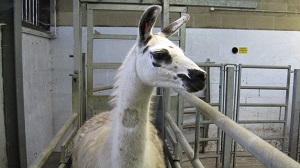How Berkshire llama Fifi is helping fight COVID-19
27 May 2020

A herd of llamas in Reading are helping UK scientists to find treatments in the fight against Covid-19.
The llamas, looked after by expert handlers working at the University of Reading, are used to provide nanobodies, very small antibodies, which can be used in a clinical environment to understand how potential drugs might bind to the SARS-CoV-2 coronavirus causing the global pandemic.
Work has already begun at the Rosalind Franklin Institute to use nanobodies which stick to the spike protein of the coronavirus, with similar work underway with the Francis Crick Institute. The herd from the University of Reading is being used to produce specialist nanobodies which may be used to block the virus from developing Covid-19 in humans.
Prof Gary Stephens from the School of Pharmacy at the University of Reading said:
“Nanobody technology is one of the most exciting new developments in medical research, and llamas play a crucial role in these studies as they are one of the very animals from which nanobodies can be produced.
“We’re pleased that the University of Reading is using its combined expertise in drug research and animal husbandry to keep a llama herd, and help the scientific effort to develop a treatment for coronavirus.
“The big benefit of using nanobodies produced by llamas is that they may be able to target the virus more effectively and are less prone to be attacked by the human body’s natural defences.”
Fifi the llama
One of Reading’s 15 llamas has been contributing to this work: a 10-year-old female called Fifi, and a further member of the herd will be helping as the work expands. The llamas receive targeted injections a few weeks apart and providing samples of blood to see if they produce antibodies that could work against the coronavirus.
Every injection or blood sample is considered one animal research ‘procedure’, regulated by a government licence and subject to inspection by Home Office expert officials, and is counted in the University’s annual reported animal research statistics. Such procedures are considered ‘mild’ on a scale of severity to the animal.
Last year, the herd had an unexpected but welcome arrival: a cria (baby llama), who was named Jeremy after a public vote (beating the second option, Boris, with twice as many votes). While Jeremy will eventually contribute to providing antibodies for research, as a one-year-old, he is currently just enjoying being part of the herd.
The nanobodies will be provided to other UK labs, including the Rosalind Franklin Institute, and the Francis Crick Institute, London.
Prof Stephens said:
“A sample of blood from a llama is screened to see whether any of their nanobodies stick to the protein used to generate the response. These can be purified and cloned to generate more identical nanobodies. If we can identify the right antibodies, including nanobodies that will work against coronavirus we can use these to develop drugs or see if they can stop the virus from producing more of itself.”
Demonstrating that llamas can produce unique nanobodies against COVID proteins will be an invaluable tool to aid our understanding of the virus and may lead to the development of a vaccine
Prof Gary Stephens
“The search is on for such drug and antibody therapies and also for vaccines to combat COVID-19. Vaccines are typically safe versions of viruses or its component, which stimulate our own immune cells to make antibodies to fight disease. Demonstrating that llamas can produce unique nanobodies against COVID proteins will be an invaluable tool to aid our understanding of the virus and may lead to the development of a vaccine.”
Professor Ray Owens, who leads Protein Production UK for The Rosalind Franklin Institute, said:
“There is an unprecedented level of team-work and collaboration globally to image, understand, and treat COVID-19. We are working with colleagues at the University of Reading and Oxford to develop a pipeline for nanobodies to gain insights into the structure of the virus that causes COVID-19.”
Svend Kjaer, Deputy of the Structural Biology Science Technology Platform at the Crick said:
“The collaboration with the CEDAR llama facility is a great opportunity for the Crick to generate sustainable supplies of versatile, high-value nanobodies for multiple applications in on-going Covid-19 research programmes”.
